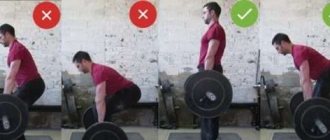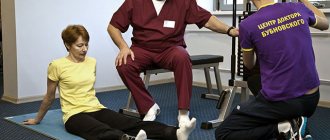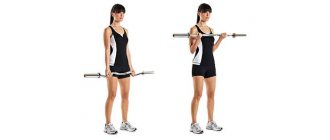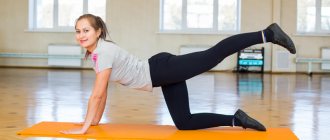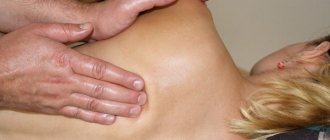No one is immune from the occurrence of pain in various sections of the spine. Millions of people suffer from constant back or neck spasms. Acute pain in the neck and back bothers you, you have problems with blood pressure and sleep disturbances, your salvation is in these exercises! These are the simplest yoga poses for beginners.
Literally after the third workout, you will feel the results, your muscles will gain strength, and your body will get stronger and begin to obey you better. Your sleep will be like that of a baby, after which you will feel fresh and rested. Your head will become clear, and you will easily solve the tasks assigned to you. Any anxiety in the neck and lower back will disappear.
How does cervical osteochondrosis manifest?
The cervical vertebrae are significantly smaller than the lumbar vertebrae. This area contains thousands of blood vessels and nerve endings. When minimal tension occurs, nerves are compressed and vascular obstruction occurs, which over time leads to the development of edema, hernias, and protrusions. When the blood supply is disrupted, an inflammatory process often occurs, which leads to pathological changes and even disability.
Symptoms of the disease depend on its type.
- Cervical radiculitis - pain radiates from the neck to the shoulder blade, spreading to the fingers through the forearm. Often the sensitivity of the fingers and hands disappears.
- Irritative-reflex syndrome - intense boring pain occurs in the neck and back of the head. It radiates to the shoulder, chest, and often manifests itself in the forearm.
- Vertebral artery syndrome - the headache does not go away, there is noise in the ears. Suffering from dizziness and visual disturbances. It is recognized as the most dangerous type of cervical osteochondrosis, which leads to impaired blood circulation in the brain. It is impossible to fight it only with gymnastics for the neck and back.
- Cardiac syndrome - pain is localized in the neck, shoulder blades, and heart. Intensifies with sneezing and turning the head.
Causes of pain
There are a large number of factors that can lead to a pain attack in the back. The most common reasons:
- Excessive tension in the muscles of the spinal column (paraspinal muscles).
- Muscle spasm of a certain segment of the spine.
- Dystrophic changes in the muscle corset.
- Injury to muscles, skeleton, ligaments.
- Inflammatory processes.
- Neurological disorders.
- Congenital defects in the back area.
These and many other reasons can cause pain in the spine. Often the pain can be sudden (like a pinching or “lumbago”) or last for a certain period of time with periods of intensification and weakening of the symptom.
Spinal diseases, and in particular the pain they cause, greatly reduce a person’s quality of life, limiting physical activities to a minimum. The patient literally cannot get out of bed, bend over, pick up objects from the floor, and so on.
Treatment of cervical osteochondrosis
Osteochondrosis is dangerous not only due to constant pain, but also to the risk of complications. Therefore, if you have prolonged and intense pain in the neck area, you should definitely consult a specialist. In the initial stages of the disease, you will only be recommended exercises for the neck for osteochondrosis. In an advanced state, the disease requires drug therapy to eliminate inflammation and restore vascular patency. In some cases, it is necessary to wear a special corset to support the head.
However, in each case you cannot do without exercises for the neck muscles. Their main task is to strengthen the muscles of the cervical spine to properly support the joints of the spine. When performed regularly, gymnastics gives a noticeable effect: the intensity of pain decreases or it goes away completely, normal blood flow is restored, and well-being significantly improves.
It is only important to remember that exercises to strengthen the neck muscles do not cure the disease. It doesn't go anywhere! And it won’t bother you only when you do the right set of exercises. As soon as gymnastics for the neck for osteochondrosis is forgotten, the unpleasant sensations will return in a week or two.
Indications for use
Exercises will be useful for:
- spinal osteochondrosis;
- protrusions of intervertebral discs;
- intervertebral hernias;
- scoliosis;
- displacement of the vertebrae (spondylolisthesis);
- radiculitis;
- posture disorders.
Regular exercises contribute to:
- strengthening and restoring muscles;
- stretching the spine;
- improved blood circulation, which allows nutrients to be better absorbed into tissues;
- relaxation of smooth muscles;
- restoration of functions of intervertebral structures;
- eliminating pain.
Individually developed programs normalize biochemical processes in the body, restore the functionality of intervertebral discs, muscles and ligaments, help reduce hernias and even completely eliminate them.
For scoliosis, exercise helps restore normal function of the back muscles. Bringing them into tone allows you to maintain the spine in the correct position.
Strong muscles hold the vertebrae and do not allow them to move during sudden movements of the body, lifting heavy objects, and reduce the likelihood of injury. With moderate loads, metabolic processes in the body are normalized, which allows vitamins and nutrients necessary for bones and cartilage to be better absorbed.
For those who lead a sedentary lifestyle, gymnastics helps:
- normalize blood flow, saturate tissues with oxygen;
- reduce the load on the spine;
- eliminate spasm of smooth muscles;
- increase performance;
- release pinched nerve endings, which leads to the disappearance of pain.
Gymnastics for cervical osteochondrosis
The complex includes exercises to relax the neck muscles and strengthen them.
- Stand or sit on a chair with your back straight. Relax your arms, lower them down. Turn your head left and right 10 times as far as you can. If pain prevents you from turning, make several sharp jerks of your head to the right and left.
- Stay in the same position. Lower your head down and try to touch your chin to your chest. Stop for 10 seconds. Perform 5 head tilts.
- Sit on a chair, relax your arms. Tuck your chin in and try to move your head back. Do 10 movements. The exercise is useful for stretching the posterior cervical muscles and is indicated for people who are forced to work in a tense position.
- Sitting on a chair, place either palm on your forehead. Tilt your head forward, pressing firmly with your palm on your forehead. Hold for 10 seconds, take a break, repeat 10 times. By tightening the muscles, the exercise helps strengthen the front of the neck and ensures correct head position.
- Stand up, relax your arms. Raise your shoulders as high as possible and hold for 10 seconds. Relax your shoulders and take a deep breath, feel your hands pulling your shoulders down. Repeat 5-10 times.
- Lie on your back on the floor. Raise your head, hold for 10 seconds, put it on the floor. Repeat after 5 seconds. Do 8 times.
- Ask an assistant to forcefully massage the muscles between the bone of the occipital region and its soft part. At first you will feel intense pain, which will be replaced by significant relief.
- Lie on the floor and ask an assistant to massage the upper part of the shoulder blade - the attachment point for the main cervical muscle. Painful sensations will be replaced by pleasant warmth.
These neck exercises for osteochondrosis will help you live with an unpleasant disease without discomfort.
Our neck is made up of vertebrae that extend from the back of our head to our upper torso. Between the vertebrae there are special discs that absorb pressure. The bones, ligaments and muscles located in the neck all work to support the head and allow movement. Any anomaly, injury or inflammation in the cervical spine leads to pain.
What to do if your neck hurts? After all, this happens to everyone from time to time. This is often due to overexertion or poor posture. Sometimes the pain can be the result of an injury from a fall or playing sports.
Most often, you can get rid of neck pain in a couple of days at home without additional remedies; if it is quite minor, it goes away on its own. Sometimes it can be a warning of serious injuries and illnesses, and requires immediate examination by a specialist. If your cervical spine pain is severe, persists for more than a week, and is accompanied by other symptoms, consult your doctor immediately.
When does your neck hurt? This may be due to a number of reasons.
The video will tell you why your neck hurts, what to do when your neck hurts, and how to relieve pain in 35 seconds.
Muscle tension and sprains
Most often this happens due to:
- poor posture;
- staying at your desk for too long;
- poor posture during sleep;
- neck injuries during exercise.
Injuries
Our neck is especially vulnerable to falls, car accidents, sports, and other activities that force the muscles beyond their normal range of motion. If the cervical vertebrae are fractured, there is a high probability that the spinal cord is also damaged.
Heart attack
Neck pain can be a symptom of a heart attack. However, usually in such cases it appears along with other symptoms, such as:
- labored breathing;
- increased sweating;
- weakness;
- vomit;
- pain in the arms or jaw.
If you notice several of the listed symptoms, call an ambulance immediately.
Meningitis
Meningitis is an inflammation of the thin lining of the spinal cord and brain. In many cases, patients with meningitis, along with fever and headache, note discomfort and congestion in the neck. This is a very dangerous disease that can be fatal. If you notice symptoms of meningitis, seek medical help immediately.
Other reasons
- Rheumatoid arthritis causes discomfort, joint swelling and bone spurs. As arthritis develops, severe pain appears in the neck area.
- Osteoporosis leads to weakening of bone tissue and fractures. The hands and knees are usually at greatest risk, but the neck is also often affected.
- Fibromyalgia is a condition that causes muscle pain throughout the body, especially in the neck and shoulders.
- With age, intervertebral disc degeneration occurs. This condition is also called osteoarthritis - a narrowing of the space between the cervical vertebrae, which increases stress on the neck and causes pain.
- As a result of injury, the intervertebral disc can begin to protrude significantly, which increases the load on the spine and nerve endings, causing discomfort.
- Spinal stenosis occurs when the spine narrows and causes pressure on the spinal cord or nerve roots as it exits the vertebrae. This may be the result of long-term inflammation caused by arthritis and other diseases.
In rare cases, neck pain may result from:
- congenital anomalies;
- infections;
- abscess;
- tumors;
- spinal cancer.
Exercises for the lumbar region
Below we give an example of a complex that contains exercises for the prevention of back pain, namely the lumbar region. They can also be done for chronic pain syndrome.
- Position yourself on your back. Tighten your abdominal muscles for a few seconds and let your stomach rest. Do this up to ten times.
- Lie down and lift your body, do not move your legs.
- Remain lying the same way. Knee joints are bent, turn in different directions.
- Knees in the same position. Pull your right hand towards your left leg, your left towards your right.
- Get on your knees and hands. Bend your back in different directions.
- Lie down on your stomach area. Spread your legs. Lower your upper limbs. Perform alternate leg lifts and stop them in the air.
These physical exercises for back pain give good results if you do them daily and 10-15 times.
You can also make a different complex. See photo below.
When to see a doctor
If symptoms persist for more than a week, you should consult a specialist. You should also go to the hospital if you have the following symptoms:
- severe neck pain for no reason;
- tumor;
- headache;
- inflamed lymph nodes;
- weakness;
- vomit;
- problems with swallowing and breathing;
- nausea;
- numbness;
- tinnitus;
- pain that spreads from top to bottom to the arms or legs;
- inability to move your arms;
- inability to touch your chin to your chest;
- bladder or bowel dysfunction.
Also see a doctor immediately if pain occurs as a result of a fall or accident.
Contraindications for use
An exercise for back pain from any complex can cause harm if:
- spinal cord damage;
- osteomyelitis;
- bone tuberculosis;
- malignant tumors in the spine;
- severe diseases of the heart and blood vessels;
- osteoporosis;
- exacerbation of chronic pathologies;
- mental disorders.
How to treat neck pain
First, the doctor will check your physical condition and medical history. Be prepared to talk about all the nuances of your symptoms. It's also worth mentioning any medications you've taken recently. Any information about existing injuries, even if it seems to you that it has nothing to do with the problem, will be useful.
The treatment method depends on the diagnosis. In addition to a general examination and analysis of your medical record, the doctor may also prescribe additional tests:
- blood analysis;
- X-ray;
- CT scan;
- MRI scan;
- electromyography, which allows you to check the health of muscles and the nerve endings that control them;
- lumbar or spinal puncture.
Depending on the test results, the doctor will refer you to the appropriate specialist. Treatment may include:
- thermotherapy;
- Exercise therapy and stretching;
- painkillers;
- corticosteroid injections;
- muscle relaxants;
- neck brace;
- traction traction of the spine;
- antibiotics (if there is an infection);
- hospital treatment (for meningitis and heart attack);
- surgery (rarely used).
Alternative treatments include:
- acupuncture;
- chiropractic;
- massage;
- transcutaneous electrical nerve stimulation.
Whatever the treatment method, be sure to see a certified professional.
Exercises for the neck: results
If you do neck exercises correctly and regularly, you can achieve the following results:
- tension will be relieved from the muscles of the neck and spine;
- blood circulation will improve;
- the muscles of the thoracic spine will be effectively stretched;
- the normal distance between the vertebrae will be restored;
- will provide a massage effect to the thyroid gland;
- blood pressure returns to normal;
- hearing and vision improve, colds are prevented;
- the youthfulness of the neck skin is preserved.
How to get rid of neck pain at home
If the pain is mild, try the following treatments:
- Apply a cold compress to the injured area for the first couple of days. Immediately after this, use a hot compress or take a hot shower;
- Avoid sports, heavy lifting, and activities that increase pain for a few days. As symptoms improve, gradually return to your normal level of activity;
- Do neck exercises every day. Slowly pull your head from side to side, from top to bottom;
- Watch your posture;
- During a call, do not hold the phone between your neck and shoulder;
- Change your body position more often. Don't sit or stand for too long without moving;
- Give a light neck massage;
- When sleeping, use a special neck pillow;
- Do not wear a neck brace without first consulting a specialist. Improper use may worsen symptoms.
How to build an individual gymnastics complex
- In acute periods and in the presence of complications, only the first 2-3 exercises from the warm-up, isometric gymnastics and several final exercises are used.
- During remission, gymnastics for cervical osteochondrosis includes from 2 to 10 warm-up exercises, isometric, dynamic, additional exercises and 3-5 final exercises.
- When you manage to complete each exercise in full and easily, you can add additional load (warm up with dumbbells or complicate the complex).
Conclusion
Gymnastics for cervical osteochondrosis is a necessary element of treatment. But its effectiveness is directly proportional to the time you devote to it and the regularity of its implementation. Rare, irregular and short-term exercises will not give the desired result and will not affect the condition of the spine in any way. It is also important to follow the rules of training, starting with a warm-up and ending with relaxation exercises. To avoid complications and deterioration of the condition, do not allow overexertion and pain during exercise.
Author: Svetlana Agrineeva
Stretching helps you forget about pain
While working, try to keep the monitor at eye level, sit up straight, keep your back straight, do not slouch or lower your head too low. When driving or surfing the Internet on your smartphone, try to give yourself short rest periods so that your cervical vertebrae do not move too far forward.
The key to getting rid of pain is proper movements and proper stretching. The following exercises for the back and neck can be done both at work and while driving:
- Make 10 circular movements with your shoulders back;
- Squeeze your shoulder blades together 10 times;
- Keeping your head straight, press the back of your head as hard as possible into the back of the chair and stay in this position for 30 seconds;
- Tilt your head to the side as close to your shoulder as possible, 10 times on each side.
Useful tips for patients
Exercise for back pain, regardless of the chosen technique, can be used to eliminate discomfort only after consulting a specialist who will assess the patient’s health condition and determine possible contraindications.
You can exercise at any convenient time; morning exercises are especially useful. You should choose comfortable clothes that do not restrict movement, but also do not allow you to freeze. If possible, some exercises can be performed at work.
Each period of the disease has its own recommendations that should be taken into account:
- spicy. You can only exercise between attacks of pain, combining exercises with other types of therapy. It is advisable to start under the supervision of an instructor, and then do gymnastics on your own. The level of physical activity is minimal, the range of movement is small. Depending on the severity of the condition, the starting position is selected, which should be lightweight. If pain appears or increases, the activity must be interrupted;
- subacute. The exercises begin when the pain subsides. The purpose of the lesson is to reduce the vertical load on the spine, increase the range of motion in the lower extremities and lower back, and strengthen the muscle corset;
- recovery period. Physical activity and range of motion can be increased. After classes, it is advisable to wear a corset.
The next day after exercise, muscle pain may be felt. This is normal, but it is better to continue training when the discomfort passes (after about 2-3 days).
Be careful in your sleep
If you are often bothered by pain in the cervical spine, then you should be more careful about the conditions and position in which you sleep. Try to sleep only on your side or back—never sleep on your stomach.
When you sleep on your stomach, you turn your head in one direction or another and your neck freezes in an unusual position for several hours. Such a dream can negatively affect the condition of the lower back, since in the absence of proper support, the stomach “falls” down.
For minor pain, in addition to exercise, follow these recommendations:
- Apply a cold or hot compress to the injured area. Use ice for the first 48-72 hours, then switch to hot compresses. Do not use the compress while sleeping as it may cause injury.
- Take over-the-counter pain relievers such as ibuprofen and acetaminophen;
- Keep moving, but avoid movements that increase pain. This will help reduce symptoms and inflammation.
- Give a light neck massage.
- Try sleeping on a firm mattress without a pillow or on a special neck pillow.
- Ask your doctor about the need to use a neck brace. Do not wear the brace for too long, as this may weaken the muscles.
When to expect an effect
Exercise for back pain, regardless of the technique, does not give an immediate effect. The body will restore normal functioning after some time. With systematic and correct exercises, the condition will gradually improve. By exercising for an hour a day, three times a week, you can expect results in a month.
Lack of movement, poor nutrition, various injuries and diseases of joints and muscles contribute to the appearance of pain in the back of varying intensity. Over time, the ability to move freely is lost, resulting in a decrease in performance and a deterioration in the quality of life.
To prevent this and get rid of back pain, you should engage in comprehensive rehabilitation of the spine, performing special exercises and taking medications if necessary.
Therapeutic gymnastics is not difficult to perform, it does not require the use of special sports equipment, and you can do it yourself at home. The main thing is to choose the right exercises by contacting a specialist.
Gymnastics for the neck: prevention and precautions
In neck gymnastics, the head is used as a natural weight, and the exercises are aimed at stretching the entire spine. The basic rules that must be followed when performing it are as follows:
- Muscle tension in the neck during movement is eliminated. Remember that you cannot strain these muscles - it is unsafe.
- Sudden movements and movements with serious efforts are excluded. For example, if we tilt our head, it is as if we are simply gently dropping it onto our chest, while stretching the cervical spine.
- When moving, we use purely gravity, and the weighting agent, as already mentioned, is our head.
Charging takes approximately five minutes. Another five minutes are spent on the preliminary warm-up, and another five on the final cool-down. Thus, fifteen minutes a day is enough, and your neck will be in excellent condition.
At first, you may feel dizzy when doing the exercises. If you feel this symptom, immediately sit on a chair and continue the exercise while sitting. After a few days, the body will get used to it, and the dizziness should go away.
The neck muscles may also hurt at first. Please note that exercise frees up the blood vessels, blood flows better to the head, and a lot of oxygen can cause dizziness and a slight feeling of euphoria.
If after charging you feel a headache , the reasons for this may be the following:
- You've gone overboard with the spins. It is better to start small and only gradually increase the amplitude and speed.
- You rise too quickly from a head-down position. Get up slowly so that the blood does not drain too much and cause unpleasant symptoms.
Be careful and careful, and charging will only benefit you. It will prevent many troubles and help maintain youth, beauty and health. We invite you to watch a video of neck exercises illustrating the exercises.
Exercises for the neck: exercises
To prevent osteochondrosis and other unpleasant problems, it is worth doing neck exercises every day so that the muscle tissue is constantly developed. It is gymnastics that will help restore the normal position of the vertebrae and improve blood circulation. However, before you start exercising, do a short warm-up to warm up your muscles. It may include the following exercises:
- Tilt your head forward and back. Then give it circular motions.
- Now, fully, but without sudden movements, turn your head alternately in both directions.
- Tilt your head left and right.
Recommendations and rules before conducting a physical therapy session
Therapeutic exercise, or exercise therapy for short, is aimed at eliminating pain and discomfort in various parts of the spine. To eliminate cervical osteochondrosis, there are several important recommendations:
- Before performing the exercises, you should do a general warm-up of the whole body.
- the room must be ventilated.
- classes are held half an hour before or after eating.
- At first, a few simple exercises are done.
- you need to breathe through your nose.
- To better warm up the muscles, you can massage or rub the cervical region with a soft towel.
- the load and number of exercises should be increased gradually.
If you feel unwell, have muscle compression, or have any inflammatory diseases of the spine, physical therapy is not recommended.
